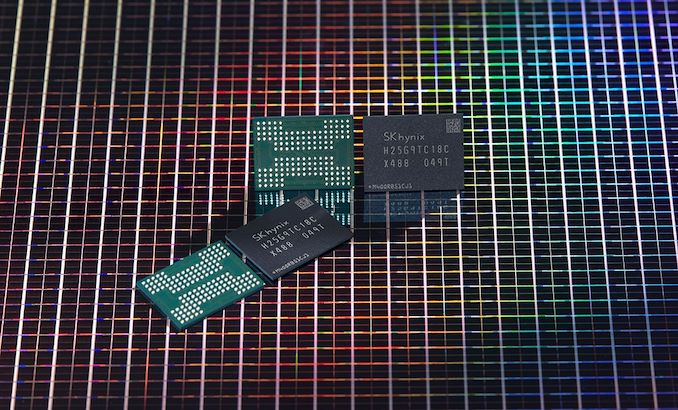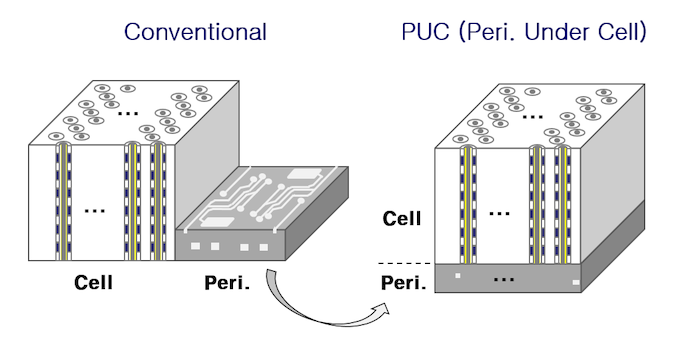SK Hynix Announces 176-Layer 3D NAND
by Billy Tallis on December 7, 2020 8:00 AM EST
SK hynix has announced their latest generation of 3D NAND, now featuring 176 layers of charge trap flash memory cells. SK hynix is the second NAND manufacturer to reach this layer count, following Micron's announcement that their 176L NAND was starting to ship in Crucial-branded products.
This is SK hynix's third generation to feature their Periphery under Cell (PUC) design to reduce die size by placing peripheral logic under the memory cell array, similar to Intel and Micron's CMOS Under Array design. (SK hynix refers to the combination of this die layout and their charge trap flash cells as "4D NAND".) Changes with this generation include a 35% increase in bit productivity (only slightly less than theoretically possible with the jump from 128 to 176 layers) and a 20% increase in cell read speed. The maximum IO speed between NAND dies and the SSD controller has been increased from 1.2GT/s for their 128L NAND to 1.6GT/s for the 176L NAND.
SK hynix has started sampling a 512Gbit TLC part to SSD controller companies for developing compatible firmware. SK hynix plans to initially use their 176L NAND for mobile products (ie. UFS modules) which will offer 70% faster read speeds and 35% faster write speeds, due to be introduced around the middle of next year. The mobile products will then be followed up by consumer and enterprise SSDs. SK hynix also plans to introduce 1Tbit dies based on their 176L process.
Based on this announcement, it appears that SK hynix will be fairly competitive during the upcoming generation of 3D NAND. They may be running a bit behind Micron's schedule, but Micron has been pursuing an unusually quick transition to 176L after using their 128L generation as a low-volume test vehicle to work out any issues resulting from their switch from floating gate to charge trap cell design. Meanwhile, Intel's 144L NAND should be arriving early next year, and Kioxia/Western Digital 112L NAND is due to show up any day now. Samsung's 128L NAND started shipping a few months ago in the 980 PRO. While they have not officially announced specs for their next generation, it is expected to go into production next spring with a layer count in the neighborhood of 176L, and to be Samsung's first generation to use string stacking—a technique their competitors all had to adopt while layer counts were in the 64-96L range.
Related Reading:
- Micron Announces 176-layer 3D NAND
- SK Hynix to Buy Intel’s NAND Memory Business For $9 Billion
- The Best NVMe SSD for Laptops and Notebooks: SK hynix Gold P31 1TB SSD Reviewed
- Western Digital and Kioxia Announce BiCS5 112-Layer 3D NAND
Source: SK hynix











29 Comments
View All Comments
Mikewind Dale - Friday, December 18, 2020 - link
How much data do you think the average user is writing?I built myself a computer two years ago that I use for both work and gaming. My 2 TB Samsung 970 EVO shows 47.84 TB written. But it's rated for 1,200 TBW over its lifespan. So it has used 1/25 of its life over 2 years. At this rate, it will take me 50 years to exhaust its TBW.
Now, granted, I'm not a professional video editor who writes several GB per day. But most people aren't.
Oxford Guy - Monday, December 14, 2020 - link
"Seriously this is pretty basic economics."Yes. Why pursue a superior technology when an inferior one can be sold instead?
Alexvrb - Sunday, December 20, 2020 - link
Your mind must have been wiped clean when your hard drive died that you forgot how common it was for old hard drives to die. Seriously, a garbage tier SSD is better than a garbage tier HDD, and a good SSD is better than a good HDD. Repairing PCs in not-so-distant past meant dealing with a lot of dead or dying HDDs, recovering data from which was a PITA (though sometimes fruitful). I think the only one I couldn't recover *ANY* data from was a first-gen Raptor that suffered a sudden catastrophic failure.I might wax poetic about older systems and consoles from time to time, but I don't miss HDDs. If I ever rebuild an old system, I'll probably use adapters and an SSD for reliability sake.
Wereweeb - Saturday, February 6, 2021 - link
"SSD's are so good, I really wish they were as bad as HDD's"Spunjji - Wednesday, December 9, 2020 - link
At least these endless goalpost-moving SSD-price posts have finally found a place to move them to that will probably never be reached. First it was 1$ per GB, then 50c per GB, then 25c per GB, and now that we're around 10c per GB you're out here asking for just over 1c per GB.You can't even get an 8TB HDD for 100usd yet. Settle down.
at_clucks - Friday, December 11, 2020 - link
On the other hand at least we know how much proponents of "SSD at any cost (not price)" are willing to put the price of the drive ahead of the value of their data. If your data is less valuable than the drive you already have cheap thumbdrives to fill that void, you can even cram a few in a 2.3" or 3.5" case... This is all an average consumer who looks at price, capacity, and with a bit of luck also at the interface to their computer sees.HDD prices shouldn't be the reference. You should pay for the standard of reliability because their only purpose is to store your data. I don't want guarantees but the expected reliability should at the minimum match that of hard disks. Once that is reached I can pay a premium for the fact that the SSD is faster.
MDD1963 - Wednesday, December 9, 2020 - link
was not all that long ago when even a 60 GB SSD was $500...saratoga4 - Monday, December 7, 2020 - link
Is this a native 176 stack or is it two half stacks sandwiched?Billy Tallis - Monday, December 7, 2020 - link
It's built as two stacks per die. SK hynix has been doing that (string stacking) since their 72L NAND, and Samsung is the only one still doing single-stack NAND.faiakes - Monday, December 7, 2020 - link
"Wile they have not..."How does 'wile' get past spell check?